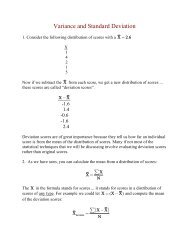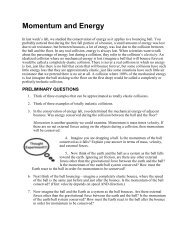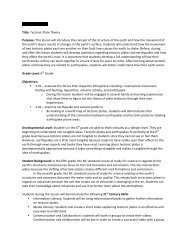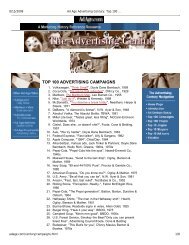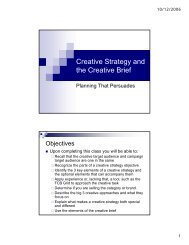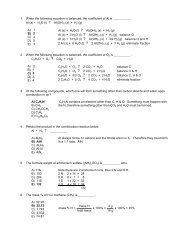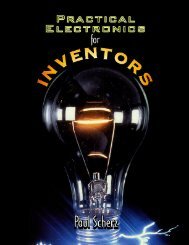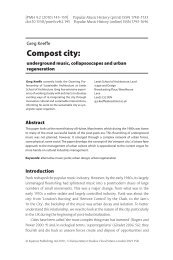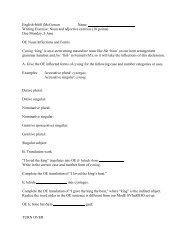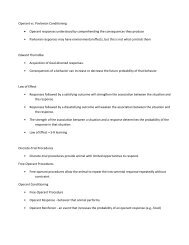Taylor's Six-Segment Strategy Wheel
Taylor's Six-Segment Strategy Wheel
Taylor's Six-Segment Strategy Wheel
You also want an ePaper? Increase the reach of your titles
YUMPU automatically turns print PDFs into web optimized ePapers that Google loves.
six-seg.htm<br />
file:///c:/Documents%20and%20Settings/Roger/Desktop/six-seg.htm<br />
1 of 3 6/10/2005 7:58 AM<br />
A comprehensive message strategy model..<br />
<strong>Taylor's</strong> <strong>Six</strong>-<strong>Segment</strong> <strong>Strategy</strong> <strong>Wheel</strong><br />
The Parts of the Model<br />
The left-hand side of the wheel represents the Transmission View of communication. The right<br />
-hand side represents the Ritual View of Communication.<br />
The wheel has a vertical axis. At the top of the axis are items that are of greatest importance to<br />
consumers, either though rational or emotional attachment. At the bottom of the axis are things<br />
of least importance. As you move clockwise from the 12 o'clock to the 6 o'clock position, the<br />
strength of the emotional attachment decreases. As you move counterclockwise from the 12<br />
o'clock to the 6 o'clock position, the strength of the rational attachment decreases.<br />
The <strong>Six</strong> <strong>Segment</strong>s<br />
The segments are discussed in a clockwise direction.<br />
<strong>Segment</strong> 1: Ego. This is the "I Am Me" segment. Consumers buy products to say to themselves<br />
"This is who I am." Products appeal to the private, fantasy worlds of consumers. Consumers<br />
could have strong emotional attachment to any brand or product category. Typical ones would be<br />
luxury automobiles, clothing. Typical message strategy: User image.<br />
<strong>Segment</strong> 2: Social. There are three sub-segments within: romantic, family and others.<br />
Consumers buy these products to win the attention, approval, admiration, love, and respect of<br />
others or to "pretend" they are members of certain social groups. Social/romantic products<br />
include expensive jewelry, perfume, candy, flowers. Social/family products include items you<br />
buy for yourself where family approval is important as well as items you buy for family<br />
members and their liking it is important to you. Social/other products include all the products we<br />
buy to win the admiration and liking of neighbors, friends, co-workers. These products make a<br />
statement to others, rather than to ourselves, about who we are. Typical message strategies: Use<br />
occasion, resonance.
six-seg.htm<br />
file:///c:/Documents%20and%20Settings/Roger/Desktop/six-seg.htm<br />
2 of 3 6/10/2005 7:58 AM<br />
<strong>Segment</strong> 3: Sensory. The sensory segments includes all produts where appeals to the five senses<br />
prevail. This segment is identical to the FCB Quandrant 4. It includes products that are<br />
purchased as "life's little treats" as well as ones that give "moments of pleasure." typical products<br />
include chewing gum, snacks, candy bars, soft drinks, costume jewelry, books, CDs and tapes --<br />
anything that gives you a temporary emotional lift. Typical message strategy: Moment of<br />
pleasure.<br />
We moved down the right-hand side of the wheel, moving from products with the greatest<br />
emotional importance to those with the least. Now we cross over the axis to products of least<br />
rational importance and move up the outside left-hand side of the wheel.<br />
<strong>Segment</strong> 4: Routine. Household goods, laundry products, and personal care products generally<br />
fall into this segment. We tend to buy the same brand time after time because there is little<br />
difference in them anyway and we buy in a habitual way. Typical message strategies: Hyperbole,<br />
pre-emptive.<br />
<strong>Segment</strong> 5: Acute Need. The need for these products arises abruptly. While we'd like to have<br />
lots of product information, the pressing need overrides the information needs. Typical products<br />
include automobile replacement parts (tires, batteries), cleaning supplies. Typical message<br />
strategy: Brand familiarity.<br />
<strong>Segment</strong> 6: Ration. This is the traditional hierachy of effects model where consumers desire lots<br />
of information about product features, services, warranties, price. Much time is spent gathering<br />
information about and comparing alternatives. Typical product categories: a house, a car, where<br />
to go to college. Typical message strategies: USP, pre-emptive, positioning, generic.<br />
Playing with the <strong>Wheel</strong><br />
You can enhance your ability to develop message strategy by generating possible strategies<br />
under each segment and then mixing and matching different segments. Here's an example. One<br />
of the simplest products in the world is bottled water. Water inside a container, not much simpler<br />
than that. What strategies might be used to promote a new brand or to promote water<br />
generically?<br />
<strong>Segment</strong> 6: Ration. Think of all the rational benefits you might reap from drinking<br />
bottled water: It's healthy, it's safe. It's better for you than soft drinks or other sugary<br />
drinks. It's handy, portable, inexpensive.<br />
<strong>Segment</strong> 5: Acute Need. When do people have acute needs for water? While hiking,<br />
exercising, running a marathon, traveling on an airplane, traveling somewhere<br />
where water supplies are not safe?<br />
<strong>Segment</strong> 4: Routine. Medical professionals advise drinking six glasses of water each<br />
day. That's a lot of routine drinking and buying. Should you be drinking water at<br />
every meal? at every break? Routinely keep a bottle on your desk?<br />
<strong>Segment</strong> 3: Sensory. How does a splash of water feel to a dry mouth? How does<br />
pouring it over your body feel when you are hot and tired? How about the sound of<br />
water being poured over ice cubes in a glass? How does the fact that it's CLEAR<br />
appeal to the eye?<br />
<strong>Segment</strong> 2: Ego. What kinds of self-images and private, fantasy worlds exist for
six-seg.htm<br />
file:///c:/Documents%20and%20Settings/Roger/Desktop/six-seg.htm<br />
3 of 3 6/10/2005 7:58 AM<br />
those who would drink bottled water? Have they just scored a winning touchdown<br />
and chugged down a bottle.? Rendered every note perfectly in a singing contest?<br />
Just scaled Mt. Everest? Finally finished that novel? Is is a secret passion? Do they<br />
store it in their private reserve? Did they just win the lottery? Or perhaps they just<br />
think of themselves as being healthy people.<br />
Now start combining segments in two's and three's:<br />
Social/acute need: What to serve when unexpected guests drop in.<br />
Sensory/routine: Quench your thirst throughout the day.<br />
Ration/routine: Drink something good for you at every meal.<br />
Ration/social/ego: Others will note how healthy you look when you drink bottled<br />
water.<br />
You can continue with combinations until you have exhausted all possible strategic<br />
alternatives.<br />
Other uses for the wheel<br />
Gather all the ads you can find for brands in a particular product category. Plot their<br />
strategies and creative themes on the wheel. What message segments are not<br />
currently being used within the product category?<br />
Take a particular product category and see if there are marketing (product, place,<br />
price promotion) changes that could extend a brand or warrant introducing a new<br />
brand for a particular segment of the wheel. Joe Boxer's move to sell underwear via<br />
vending machines in airports and hotels, for example, extends the product to the<br />
acute need segment for forgetful business travelers.<br />
What do you think of the wheel? Did it help you to develop a workable message strategy? Let<br />
me know by sending an email to retaylor@utk.edu<br />
READ MORE ABOUT IT in Taylor, Ronald E., "A <strong>Six</strong>-<strong>Segment</strong> Message <strong>Strategy</strong> <strong>Wheel</strong>,"<br />
Journal of Advertising Research, Vol 39, No.6, November/December 1999.


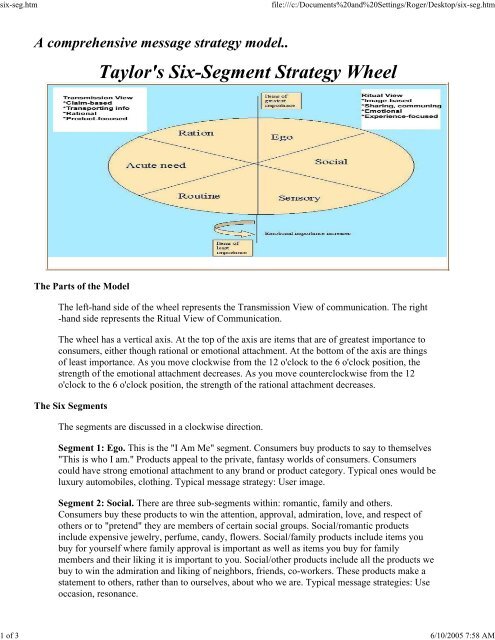
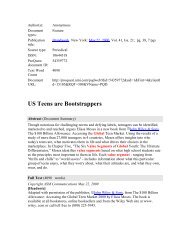

![Graduate Bulletin [PDF] - MFC home page - Appalachian State ...](https://img.yumpu.com/50706615/1/190x245/graduate-bulletin-pdf-mfc-home-page-appalachian-state-.jpg?quality=85)
